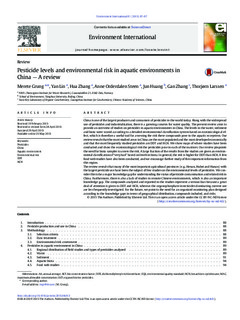| dc.contributor.author | Grung, Merete | |
| dc.contributor.author | Lin, Yan | |
| dc.contributor.author | Zhang, Hua | |
| dc.contributor.author | Steen, Anne Orderdalen | |
| dc.contributor.author | Huang, Jun | |
| dc.contributor.author | Zhang, Gan | |
| dc.contributor.author | Larssen, Thorjørn | |
| dc.date.accessioned | 2018-09-10T06:30:02Z | |
| dc.date.available | 2018-09-10T06:30:02Z | |
| dc.date.created | 2015-06-23T15:15:31Z | |
| dc.date.issued | 2015 | |
| dc.identifier.citation | Environment International. 2015, 81, 87-97. | nb_NO |
| dc.identifier.issn | 0160-4120 | |
| dc.identifier.uri | http://hdl.handle.net/11250/2561595 | |
| dc.description.abstract | China is one of the largest producers and consumers of pesticides in the world today. Along with the widespread use of pesticides and industrialization, there is a growing concern for water quality. The present review aims to provide an overview of studies on pesticides in aquatic environments in China. The levels in the water, sediment and biota were scored according to a detailed environmental classification system based on ecotoxicological effect, which is therefore a useful tool for assessing the risk these compounds pose to the aquatic ecosystem. Our review reveals that the most studied areas in China are the most populated and the most developed economically and that the most frequently studied pesticides are DDT and HCH. We show maps of where studies have been conducted and show the ecotoxicological risk the pesticides pose in each of the matrices. Our review pinpoints the need for biota samples to assess the risk. A large fraction of the results from the studies are given an environmental classification of “very bad” based on levels in biota. In general, the risk is higher for DDT than HCH. A few food web studies have also been conducted, and we encourage further study of this important information from this region. The review reveals that many of the most important agricultural provinces (e.g., Henan, Hubei and Hunan) with the largest pesticide use have been the subject of few studies on the environmental levels of pesticides. We consider this to be a major knowledge gap for understanding the status of pesticide contamination and related risk in China. Furthermore, there is also a lack of studies in remote Chinese environments, which is also an important knowledge gap. The compounds analyzed and reported in the studies represent a serious bias because a great deal of attention is given to DDT and HCH, whereas the organophosphate insecticides dominating current use are less frequently investigated. For the future, we point to the need for an organized monitoring plan designed according to the knowledge gaps in terms of geographical distribution, compounds included, and risks. | nb_NO |
| dc.language.iso | eng | nb_NO |
| dc.publisher | Elsevier | nb_NO |
| dc.rights | Attribution-NonCommercial-NoDerivatives 4.0 Internasjonal | * |
| dc.rights.uri | http://creativecommons.org/licenses/by-nc-nd/4.0/deed.no | * |
| dc.title | Pesticide levels and environmental risk in aquatic environments in China - A review | nb_NO |
| dc.title.alternative | Pesticide levels and environmental risk in aquatic environments in China - A review | nb_NO |
| dc.type | Journal article | nb_NO |
| dc.type | Peer reviewed | nb_NO |
| dc.description.version | publishedVersion | nb_NO |
| dc.rights.holder | © 2015 The Authors. | nb_NO |
| dc.source.pagenumber | 87-97 | nb_NO |
| dc.source.volume | 81 | nb_NO |
| dc.source.journal | Environment International | nb_NO |
| dc.identifier.doi | 10.1016/j.envint.2015.04.013 | |
| dc.identifier.cristin | 1250280 | |
| dc.relation.project | Utenriksdepartementet: SINOPOP2 | nb_NO |
| cristin.unitcode | 7464,30,12,0 | |
| cristin.unitcode | 7464,30,23,0 | |
| cristin.unitcode | 7464,0,0,0 | |
| cristin.unitcode | 7464,30,0,0 | |
| cristin.unitname | Akvatiske miljøgifter | |
| cristin.unitname | Nedbørfeltprosesser | |
| cristin.unitname | Norsk institutt for vannforskning | |
| cristin.unitname | Fagsenter for ferskvannsmiljø | |
| cristin.ispublished | true | |
| cristin.fulltext | original | |
| cristin.qualitycode | 1 | |

